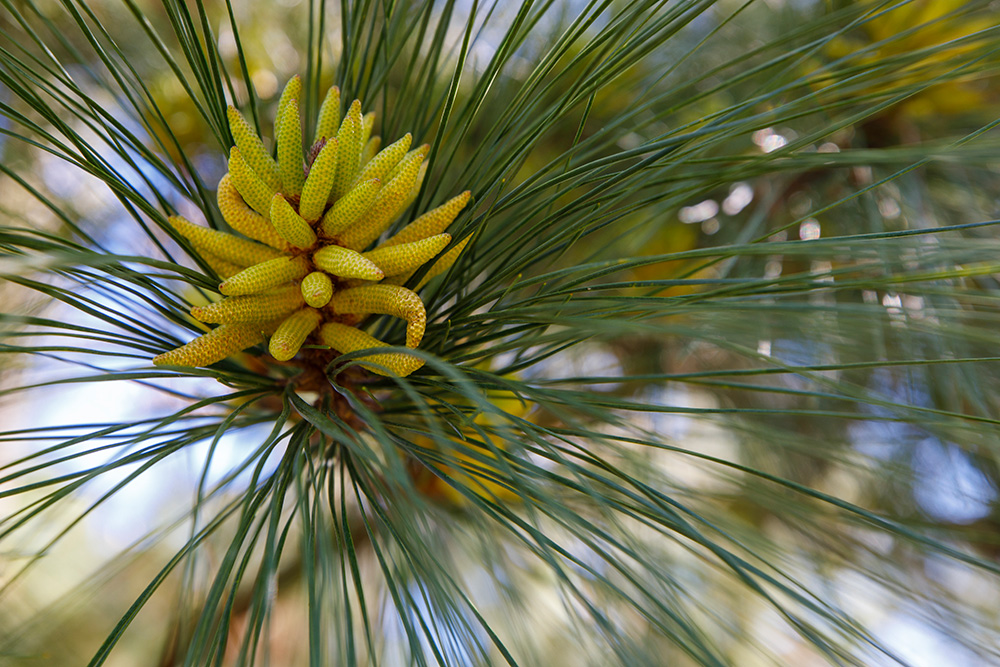NORTHAMPTON, MA / ACCESSWIRE / February 7, 2023 / Future Rayonier forests depend on the precise and careful collection of pollen. We share what pollen is and how we collect this microscopic dust to ensure the preservation of one of the world's most depended-upon resources: trees.
WHAT IS POLLEN?
If you live in the south, every January or February you'll find yourself washing tiny, yellow pine pollen particles off your car. Within these tiny pollen grains is the potential for millions of acres of forests. And because we need trees, we need pollen.
Similar to human reproduction, the flower of the pine tree is the female reproductive organ, also known as the ovule. The pollen catkin is the male reproductive organ that holds all of the pollen grains. One single pollen grain is the equivalent to one human sperm, holding the power to fertilize an ovule. Manually put the two together via controlled pollination, and the outcome equates to the desired genetically-controlled seed.
WHY DO WE COLLECT POLLEN?
At Rayonier, we collect and process our pollen by hand to ensure the genetic makeup of future seedlings is pure. The harvesting of pollen is tedious, but well worth the effort to ensure our trees have strong, disease-resistant parents.
How do we know when pollen is ready to be harvested?
When it comes to pollen, timing is everything.
In one cluster of pollen catkins, we derive millions of pollen grains essential to keeping our forests growing. Each cluster is closely monitored by our genetic research team for ripeness to ensure the perfect time for picking.
"There are multiple stages to the pollen catkins," explains Tree Improvement Forester Serenia O'Berry. "Each individual catkin, the little worm-like pieces you see within the clusters, change colors as they ripen. They start out green, and as they become more yellow and elongate, that is how you know they are getting ready for picking."
Checking for readiness means monitoring for size and performing a three stage "squeeze test" of the pollen catkins.
STAGE 1: We know a pollen catkin is in Stage 1 if when squeezed, it is still hard and snaps in half like a pea pod.
STAGE 2: In Stage 2, a gooey yellow substance will come out of the catkin, indicating that it is not quite ready yet.
STAGE 3: Stage 3 is the optimum time for picking. This is when the catkin is bendable without snapping in half, and when squeezed the liquid is clear.
We have to be careful to not miss the Stage 3 picking window. If we wait too long, the catkin opens and the pollen will fly away with the wind. This indicates that timing is everything when it comes to what we do here at Rayonier.
HOW DO WE EXTRACT THE POLLEN?
Extracting the pollen is a step-by-step process.
When we determine the clusters are ready for harvest, a team arrives to pick the clusters off of the trees. With a pair of pruning shears, the clusters are clipped off and gathered into 5 gallon buckets. These clusters are then sent to the drying room where the pollen is poured onto flat cardboard trays. Several humidifiers are turned on to extract the moisture down to less than 8% from the pollen.
Monitoring the moisture content of the pollen is of extreme importance. If the pollen is too wet when it goes into the freezer, the water molecules will expand and burst the pollen grains, making them no longer usable to fertilize an ovule.
As the pollen dries, the catkins release the pollen out of the clusters. Once this happens, the entire tray is dumped into a large sifter, we shake it, and the pollen shifts out. The catkins are thrown away, and the pollen is bottled up. After it's bottled, we store the pollen in a large industrial freezer for use the following year.
Why is collecting pollen so important to sustainable forestry?
It starts with microscopic dust.
Thousands of forests depend on pine cones and seeds, and those pine cones and seeds depend on pollen.
"You can't have one without the other," explains Serenia. "You can put on all the bags you want, but if you don't have any pollen to shoot into the bags, then you get no seed. No seed means no trees, and no trees means that we have nothing to replant after we harvest a stand. Pollen is a very crucial part to the sustainability of our land base."

View additional multimedia and more ESG storytelling from Rayonier on 3blmedia.com.
Contact Info:
Spokesperson: Rayonier
Website: https://www.3blmedia.com/profiles/rayonier
Email: [email protected]
SOURCE: Rayonier



